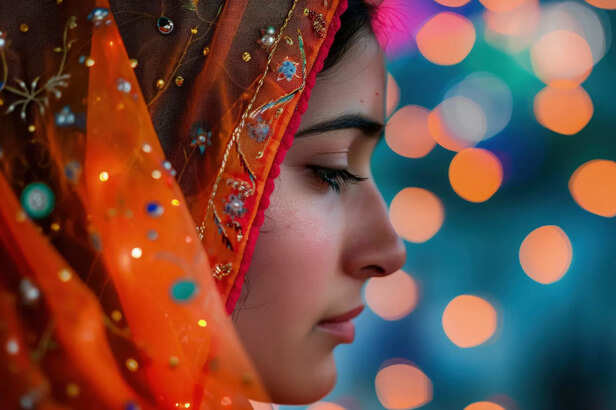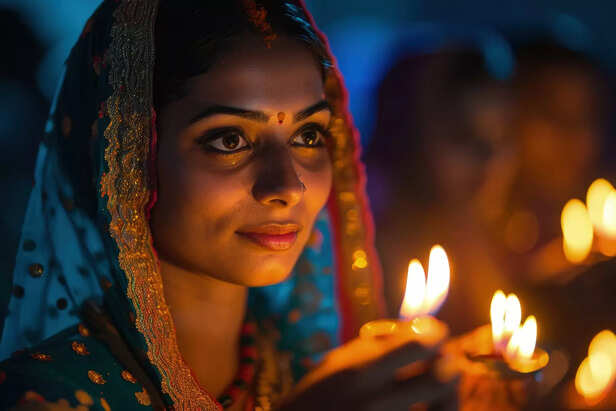Why Hindus Cover Their Head During Puja and Temple Visits
Riya Kumari | Jun 26, 2025, 13:35 IST
( Image credit : Timeslife )
Okay, confession time: I used to think covering your head in temples was like that one auntie’s way of hiding a bad dye job or, I don’t know, making a slow-motion Bollywood entrance feel legit. You know, all that fabric flying like a soap opera teaser trailer. Until I found myself at a temple, clutching a scarf like a clueless tourist in a spiritual Coachella—utterly baffled and half-convinced I was doing it wrong.
There’s something quietly powerful about watching someone cover their head before stepping into a temple or beginning a puja. It’s a simple gesture—uncomplicated, almost automatic. But like many ancient practices, its strength lies not in its flash, but in its stillness. And like most things in Hinduism, what looks like ritual often carries layers of meaning—some that speak to the body, and others that whisper straight to the soul. This isn't about rules. This is about remembering.
The Head Is Where Heaven Touches Us

In Hindu thought, the top of the head is considered the most sacred point of the body. It's not just anatomy—it’s energy. The crown chakra, or Sahasrara, sits here. It’s the center of connection between the individual and the infinite. This isn't metaphor. It's the spiritual anatomy we rarely speak of but often sense—like when we enter a place of prayer and something in us automatically softens.
Covering the head during a puja or temple visit is a way of protecting that space. Not from the world, but from distraction. It’s a soft barrier between the inner and the outer. It says: this moment is not casual. This space is not ordinary. And neither am I.
Stillness Begins With Intention

In a world constantly pulling our attention outward, a practice that pulls it inward is a gift. Head covering isn’t about modesty in the way we often misunderstand it. It’s about preparing the mind to turn inward—to become receptive, calm, attentive.
We don’t rush into the sacred. We arrive with awareness. And sometimes, something as small as covering the head can help remind us to pause, to breathe, and to mean it.
More Than Culture—It’s Consciousness

For many, the act has become cultural, yes. Tied to tradition, family, and habit. But underneath the familiarity is something much older than culture—consciousness. Every religion has symbols. But in Hinduism, a symbol is never just a symbol. It is a tool. And this tool isn’t only about showing reverence to a deity—it’s about showing reverence to the divine within us.
Because the way we approach the sacred outside is often a reflection of how we treat the sacred inside. When we cover our head, we’re not bowing to a rule. We’re rising to a deeper state of awareness.
Respect, Not Rigidity

This isn’t a demand from scripture, nor a commandment etched in stone. It’s an offering. A sign of humility. We remove our shoes before entering a temple. We wash our hands. We speak softly. We fold our hands—not because someone told us to—but because the heart knows when it is standing before something eternal.
Covering the head is part of that language of respect. It’s a way of saying: I know I’m in the presence of something larger than myself, and I wish to receive it with grace.
What We Do Shapes What We Feel

Our actions form our awareness. Often, the ritual comes before the understanding. And that’s okay. Even if you’ve done this your whole life without knowing why, that doesn’t make it meaningless. It makes it ancestral. Some knowledge is not explained. It is remembered.
And in a time when forgetting comes so easy—forgetting who we are, where we come from, what quietness feels like—this one small gesture helps us remember.
A Final Reflection
The sacred doesn't always shout. Often, it arrives quietly—wrapped in a soft piece of cloth, in a temple echoing with chants, or in the stillness between two folded palms. Covering the head may seem small. But in that act lies a choice: to honour the invisible, to slow down, to say without words—I am here, fully, humbly, and open.
And sometimes, the most powerful prayers are the ones we don't speak. Only live. Let it be that simple. And that sacred.
The Head Is Where Heaven Touches Us

Indian
( Image credit : Freepik )
In Hindu thought, the top of the head is considered the most sacred point of the body. It's not just anatomy—it’s energy. The crown chakra, or Sahasrara, sits here. It’s the center of connection between the individual and the infinite. This isn't metaphor. It's the spiritual anatomy we rarely speak of but often sense—like when we enter a place of prayer and something in us automatically softens.
Covering the head during a puja or temple visit is a way of protecting that space. Not from the world, but from distraction. It’s a soft barrier between the inner and the outer. It says: this moment is not casual. This space is not ordinary. And neither am I.
Stillness Begins With Intention

Hindu
( Image credit : Pexels )
In a world constantly pulling our attention outward, a practice that pulls it inward is a gift. Head covering isn’t about modesty in the way we often misunderstand it. It’s about preparing the mind to turn inward—to become receptive, calm, attentive.
We don’t rush into the sacred. We arrive with awareness. And sometimes, something as small as covering the head can help remind us to pause, to breathe, and to mean it.
More Than Culture—It’s Consciousness

Prayer
( Image credit : Freepik )
For many, the act has become cultural, yes. Tied to tradition, family, and habit. But underneath the familiarity is something much older than culture—consciousness. Every religion has symbols. But in Hinduism, a symbol is never just a symbol. It is a tool. And this tool isn’t only about showing reverence to a deity—it’s about showing reverence to the divine within us.
Because the way we approach the sacred outside is often a reflection of how we treat the sacred inside. When we cover our head, we’re not bowing to a rule. We’re rising to a deeper state of awareness.
Respect, Not Rigidity

Worship
( Image credit : Freepik )
This isn’t a demand from scripture, nor a commandment etched in stone. It’s an offering. A sign of humility. We remove our shoes before entering a temple. We wash our hands. We speak softly. We fold our hands—not because someone told us to—but because the heart knows when it is standing before something eternal.
Covering the head is part of that language of respect. It’s a way of saying: I know I’m in the presence of something larger than myself, and I wish to receive it with grace.
What We Do Shapes What We Feel

Hinduism
( Image credit : Freepik )
Our actions form our awareness. Often, the ritual comes before the understanding. And that’s okay. Even if you’ve done this your whole life without knowing why, that doesn’t make it meaningless. It makes it ancestral. Some knowledge is not explained. It is remembered.
And in a time when forgetting comes so easy—forgetting who we are, where we come from, what quietness feels like—this one small gesture helps us remember.
A Final Reflection
And sometimes, the most powerful prayers are the ones we don't speak. Only live. Let it be that simple. And that sacred.
